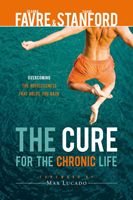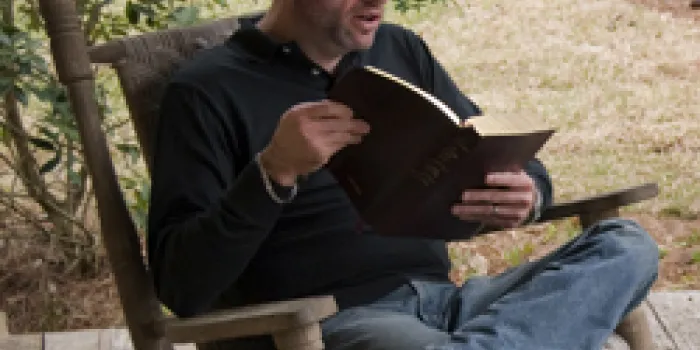HemAware “Takes 5” with people in the bleeding disorders community and spotlights their efforts with just five questions. Here, we talk with Shane Stanford, senior pastor of Gulf Breeze United Methodist Church in Florida and chief vision architect for Making Life Matter Ministries. Stanford, 40, recently wrote the book The Cure for the Chronic Life: Overcoming the Hopelessness That Holds You Back with Deanna Favre, wife of retired NFL quarterback Brett Favre. Stanford, 40, has mild hemophilia A, HIV and hepatitis C. He’s married to his high school sweetheart, Pokey, and they have three daughters.
1. What is The Cure for the Chronic Life about, and why did you write it?
Several years ago, I wrote another book called When God Disappears. It was about difficulties that people go through when they feel like they are too far gone to connect into faith and into relationships with God and with others. I invited Deanna Favre to write the foreword to that book, and it started a friendship. Both of us have dealt with difficulties; she is a breast cancer survivor, has dealt with the loss of several family members and went through addiction [issues] with her husband. I also have dealt with chronic illness.
We were talking one day about how you get into patterns of dealing with chronic illness that cause you to turn inward. We’ve seen people with perfectly healthy bodies who go through chronic patterns in their life. We defined the “chronic life” as a series of unhealthy patterns that keep people from achieving their potential. These patterns can be relational, emotional, dealing with an addiction, whatever it might be. It’s any type of pattern that is keeping that person from being able to experience the possibilities of their life.
As we got to talking with friends and doing a little bit of research, we realized there were some really simple but powerful ways that you can address these patterns. They not only help you get out of them, but help reframe your life for more healthy ways of dealing with others, of approaching decisions, of making your relationships stronger and healthier. That’s what the “CURE” is.
2. What does the CURE stand for?
The CURE talks about four things you must do in order to turn your life back outward, to be able to help focus on what it truly means to be able to live your life in healthy ways. The first one is “Compassion.” The word “compassion” literally means to step into the shoes of someone else, to see the world from their perspective. We talk about what would happen if people would see the world from the perspective of their brother or their sister. It would change everything.
help focus on what it truly means to be able to live your life in healthy ways. The first one is “Compassion.” The word “compassion” literally means to step into the shoes of someone else, to see the world from their perspective. We talk about what would happen if people would see the world from the perspective of their brother or their sister. It would change everything.
The second one is “Understanding.” We talk about how once you see the world from a new perspective, you’re also called to renew your mind. And because we come from a background of faith, we use the passage from Romans, Chapter 12, where Paul says that you’ve been called to present yourself as a living and holy sacrifice for the renewing of your mind. And it’s through the renewing of your mind, or the deeper understanding of the situation, that you’re not just able to recognize bad patterns versus healthy patterns, but you can then begin to plan how you’re going to move out of those unhealthy patterns.
Then you have “Response.” It’s not enough for us to simply understand it—we have to respond. Part of life is the intersection of these paths that allow for us to build new relationships and to make healthy decisions, to actually put some action behind our thinking.
The final one is “Encouragement.” The more you do this, the more you see the world from someone else’s perspective, and the more you understand it, the more you respond. You don’t just offer encouragement; you become an encouragement.
There’s a 40-day treatment plan that goes along with the book. There are 10 days of treatment under each of the four areas of the CURE. The goal is that at the end of those 40 days, you will have transformed your life. That’s the purpose of the book.
In Biblical terms, the number 40 is always used when God is trying to walk you out of something that’s not healthy and into some place that is healthy. It was used for the 40 days of the children of Israel in the wilderness; it was used for Jesus when he went into the wilderness to be tempted by the adversary. It’s a number that symbolizes transition. The reason we thought 40 would be important is because the goal is to transition someone from an unhealthy pattern of life into a healthy pattern.
3. How was your faith tested when you were diagnosed with HIV as a teenager? How did you return to your faith?
I went to bed one night as captain of the golf team, dating the prettiest girl in school and [serving as] president of my class, and the next day I was told that I’d probably had this disease for six or seven years and they didn’t know how many years I had left. It shook my faith.
I’m the type of person who has always faced things head on, and so that was the way that I had to deal with it. I couldn’t let this get the best of me, but at the same time, I didn’t know if there was any hope. It was a conversation with my grandfather that really changed the dynamic for me. He asked me three weeks after the diagnosis, “So, what are you going to do with this?” I told him I didn’t think I had a choice, and he said, “You know, son, you always have a choice in life. You can get in the corner and you can feel sorry for yourself, and I love you so much that if that’s what you decide, I’ll get in the corner with you. But, I think you’re going to choose a different route. I think you’re going to make every day count, no matter how many days you have.”
That was the formative conversation for my life: Every day would mean something, no matter what I faced, no matter what I dealt with. That’s how we got the name of our teaching ministry—Making Life Matter Ministries. And it all flows from that encounter and that conversation. It wasn’t easy. I worked my way back [to faith]. I had lots of questions and lots of difficulties understanding how God could let this happen to me. But at the same time, I didn’t want to give up. I wanted to fight, and because of that fighting spirit, I believe it helped me to reframe those issues.
4. How is your health?
Everything is fine. I take my medicines and take care of myself. But I am realizing that I’m not as young as I used to be. I’m having to do a lot of pain management right now. And I’m dealing with old injuries. But in terms of the HIV and hepatitis C, everything seems to be, at this point, under control.
5. What are you working on now?
I have a new book that will come out later this year called Making Life Matter. I have two other books that are in process. One’s called The Five Smooth Stones; the other is a project I’m doing with a friend of mine called Big Fat Failures. I am also working on a book with Laurie Beth Jones, who is the writer of The Path and Jesus, CEO.

